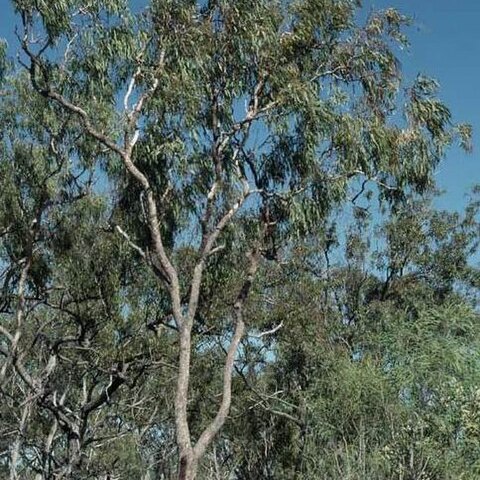Tree to 17 m tall. Forming a lignotuber.Bark rough over whole trunk, often extending to larger limbs and smaller branches, thin, tessellated, scaly, grey over red-orange; if smooth above creamy pink to pale grey.Branchlets lack oil glands in the pith.Juvenile growth (coppice or field seedlings to 50 cm): stems rounded to square in cross-section, smooth; juvenile leaves always petiolate, alternate, ovate to elliptical, 5.5–15 cm long, 2.5–5.5 cm wide, base tapering to petiole, apex pointed, green, smooth.Adult leaves alternate, petioles 1.4–4 cm long; blade lanceolate or falcate, 9–23(27) cm long, 0.8–2 cm wide, base tapering to petiole, margin entire, apex pointed, concolorous, dull or scarcely glossy, green or grey-green, smooth, side-veins at greater than 45° to midrib (penniveined), reticulation very dense, intramarginal vein apparently absent (confluent with margin), oil glands apparently absent. Inflorescence terminal compound, peduncles terete or slightly angular, 0.2–1.1 cm long, buds usually 7 per umbel, pedicels 0.3–1.3 cm long. Mature buds obovoid or pyriform, 0.6–0.8 cm long, 0.5–0.6 cm wide, smooth, glossy, scar absent (both opercula shed together at flowering), operculum shallowly rounded or rarely almost conical, stamens inflexed, all fertile, anthers oblong, dorsifixed, versatile, dehiscing by longitudinal slits, style long and straight, stigma blunt or ? with a fringe of papillae, locules 4(5), the ovules not in distinct vertical rows on the placentae. Flowers creamy white.Fruit pedicellate (pedicels 0.2–1.3 cm long), urceolate with a short to moderately long neck that is flared slightly at the rim, 1.2–1.9 cm long, 1.1–1.6 cm wide, smooth, disc descending vertically, valves 4(5), enclosed.Seeds brown, 7–8 mm long, ellipsoidal with terminal wing, hilum ventral. Cultivated seedlings (measured at ca node 10): cotyledons large, reniform; stems rounded in cross-section, setose with bristle-glands; leaves always petiolate (petioles to 0.5 cm), opposite for at least 10 nodes, narrowly lanceolate to elliptic, 7.5–10 cm long, 1.5–3.5 cm wide, base rounded or shallowly lobed, tapering at upper nodes, apex pointed or rounded, mid-green, discolorous, setose with bristle-glands.
More
Tree to 12 m. Bark smooth, white or cream-yellow throughout, or often with rough, tessellated bark on lower trunk or at base of trunk. Juvenile leaves petiolate, lanceolate, glandular-bristly. Adult leaves alternate, lanceolate, often falcate, acuminate; lamina 11–15.5 cm long, 1.2–2 cm wide, green, concolorous; lateral veins faint, at 45°–60°; intramarginal vein confluent with margin; petiole terete, 12–20 mm long. Umbels 7-flowered; peduncle terete, 10–15 mm long; pedicels 4–8 mm long. Mature buds not seen. Fruits urceolate, 12–15 mm long, 11–15 mm wide. Seeds not seen.
Tree to 17 m. Bark tessellated, scaly, red-brown on at least trunk and main branches. Juvenile leaves not seen. Adult leaves alternate, lanceolate, acuminate; lamina 15–21 cm long, 2–3 cm wide, green, concolorous; lateral veins faint, at 55°–65°; intramarginal vein confluent with margin; petiole terete, 13–25 mm long. Umbels 7–11-flowered; peduncle terete, c. 10 mm long; pedicels 2–5 mm long. Buds turbinate; operculum conical, 3–4 mm long, c. 5 mm wide; hypanthium turbinate, 5–6 mm long, 6–7 mm wide. Fruits urceolate, c. 15 mm long, c. 14 mm wide. Seeds winged.


